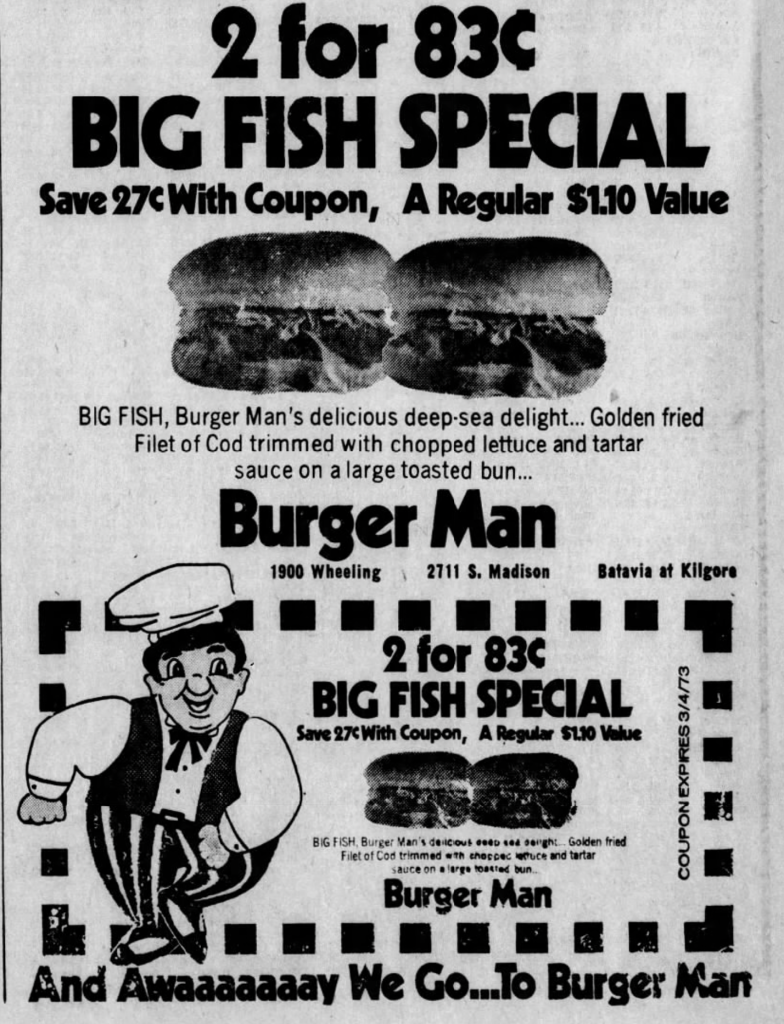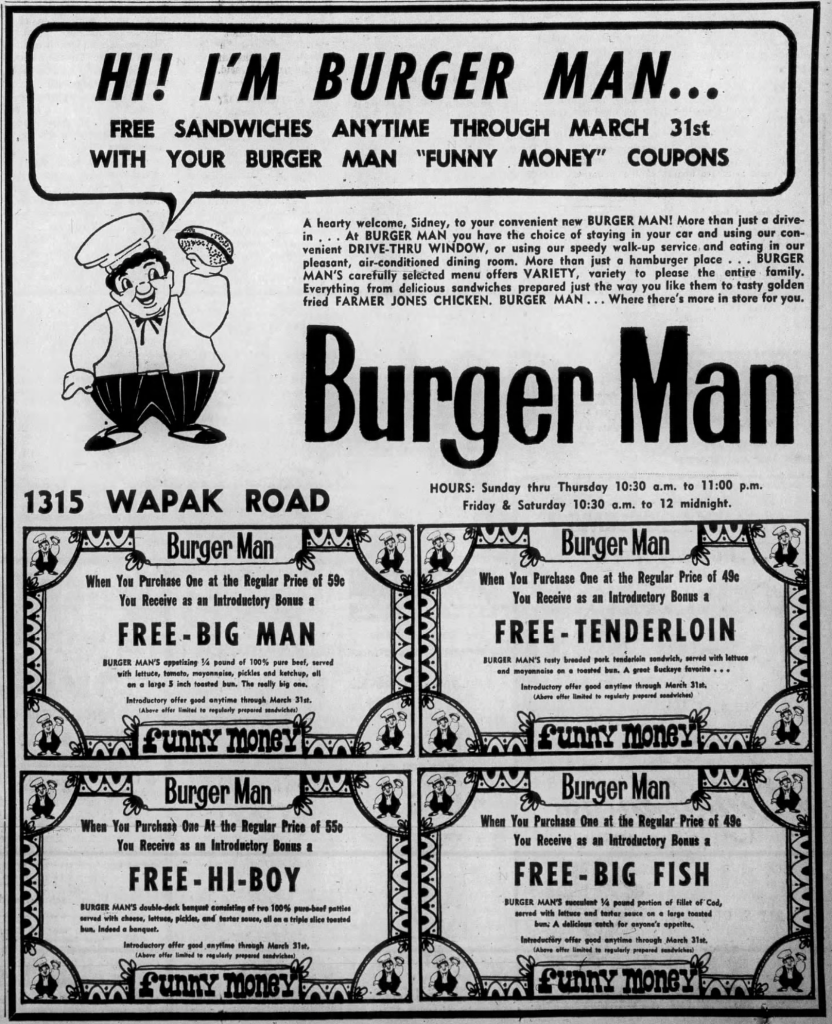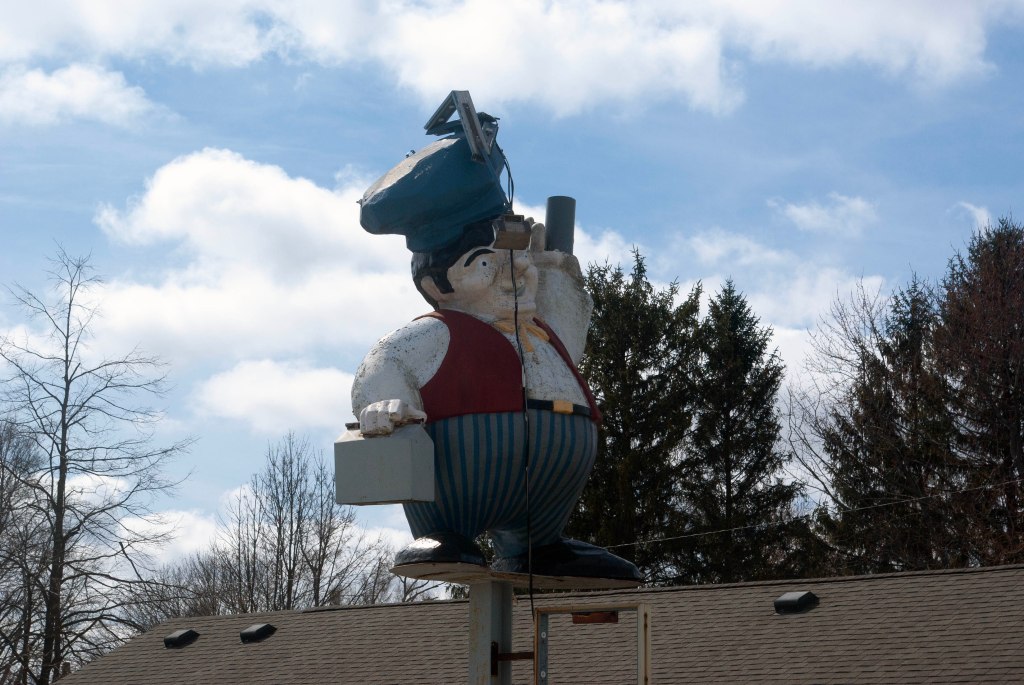I spent last night watching The Founder, a Netflix movie that chronicles Ray Kroc’s rise from struggling milkshake mixer salesman to McDonald’s magnate. It reminded me that the road to billions and billions sold is paved with also-rans, such as the original McDonald’s, which Dick and Mac renamed “The Big M” and closed six years after Kroc bought the company. In Indiana, we had Burger Chef. In East-Central Indiana and parts of Ohio, we had Burger Man.

Burger Man was founded in 1968 but it’s probably better known by the names of the restaurants it was sandwiched between it. The chain started as Mister Fifteen, and Mac’s Famous Hamburgers shared some of the company’s executives and acquired several of its restaurants after Burger Man shut down for good.
Larry Lattomus started Mister Fifteen in 1961. The company took its name as a reference to the cost of its hamburgers1, which were loss-leaders intended to get hungry patrons in the door to order something more expensive2. The chain began with two Muncie locations, one at the corner of South Madison and 21st Street and one on North Wheeling Avenue across from the new Northwest Plaza3.

A third restaurant soon opened at “the Crossroads of the City,” as the company called the corner of Jackson and Walnut streets in their marketing material. It didn’t last long, though, since by 1965, Mister Fifteen acquired land for its then-third location at West Kilgore and South Batavia avenues on Muncie’s west side4.

Architecturally, Mister Fifteen restaurants were typical of the futuristic Googie style prevalent in commercial building construction at the time. Small structures, most Mister Fifteens had a zig-zag roof that framed a tall A-frame sign at the center of the building. The store at Kilgore and Batavia was the first to feature a pair of larger-than-life statues of Mister Fifteen himself. One stood in front of the building, rotating atop a twenty-three foot tall pole5, while a second model allowed drive-in patrons to order through Mister Fifteen’s belt buckle. I think it’s creepy as I write this in 2023, but things were different in the 60s.

The Mister Fifteen statues were produced by Richard Kishel, a Ball State art professor and teacher at Burris Laboratory School, who operated a workshop, Art Forms, on West Adams Street in Muncie. After the statues became a hit, Kishel’s firm produced an ironic fifteen Mister Fifteens in 1966. Each was made with fiberglass reinforced by steel piping6.

In 1968, Mister Fifteen received national publicity when the company was featured in Drive-In Management magazine after they placed playgrounds next to their stores. The installments included picnic tables, swing sets, a “large climbing turtle,” and “stepping stones.” Lattomus told the magazine that the chain’s business had increased 30% after their introduction7. I’m sure that many of us are familiar with the concrete tortoises that Mister Fifteen installed; they were common in parks and playgrounds around Indiana and were also manufactured by Dick Kishel and Art Forms.

In many ways, Mister Fifteen’s playgrounds paved the way for McDonald’s McDonaldland playgrounds, which first appeared at a restaurant in Chula Vista, California, in 19728. Beyond their introduction and the exposure it garnered, though, 1968 was a big year for Mister Fifteen. Not even a month after the company was featured in Drive-In Management, the chain changed its name to Burger Man as part of a reorganization that acknowledged the rising cost of the chain’s hamburgers and consolidated two operations companies and a real estate entity into one. At the time, Burger Man operated three restaurants in Muncie, one in Anderson, one in Lawrence, and one in Greenville, Ohio. A month after the name change, the company was purchased by Vesco Corporation, a holding company based in Westchester, Pennsylvania10.

The reorganization saw the company aggressively franchise its concept, beginning with a store in Elwood on State Road 28, then two in Springfield, Ohio, on South Limestone Street11 and East Home Road12. In 1969, Larry Lattomus, still president of Burger Man, Incorporated as the Vesco subsidiary, announced that Wade von Kleeck had been promoted to Executive Vice President to oversee the chain’s expansion13. The following year, Lattomus resigned from the company and was replaced by F.U. Goebert. By 1971 Vesco Corporation had diversified to become a manufacturer of garage-door operators and real estate investment business, in addition to operating Burger Man14.

In 1971, another Burger Man opened in Sidney, Ohio. Later that year, Von Kleeck, Bill Kelly, and Doyne Crum formed a new company called Kelly’s, Incorporated. The trio opened a Kelly’s Family Restaurant four blocks north of Burger Man in Sidney and a second store only three blocks north of Muncie’s South Madison Street Burger Man. In 1972, Kelly’s merged with Mac’s Famous Hamburger Systems, Crum’s company, that operated eight restaurants in Indiana and Ohio from its Michigantown headquarters16.

In December of 1973 Burger Man found itself unable to pay its debts and in imminent danger of insolvency. As a result, the Vesco closed its restaurants down for good and announced that some of its buildings would be marketed towards other restaurants looking to operate under different brands17. One of those businesses was Mac’s: in 1974, Von Kleeck and Kelly purchased the Burger Man at Kilgore and Batavia, which opened as Mac’s Famous Hamburgers after a substantial renovation added a drive-through window and interior seating for eighty people18.

The Burger Man on North Wheeling Avenue in Muncie was demolished to make way for a new Long John Silver’s in 197519. By the following year, the store on 53rd Street in Anderson had become another Mac’s restaurant. Muncie’s Madison Street Burger Man was demolished around 1979 so a new Pizza Hut could be built. Burger Man’s second Anderson location, at 3rd Street and Scatterfield Road, was torn down to erect a car dealership on its foundation in 199220.

The Greenville, Ohio store appears to have been demolished to make way for CVS, while the Burger Man in Sidney later became an Arby’s and is now Al’s Pizza. Although Mac’s ultimately expanded to twenty-one fast food restaurants and steakhouses21, it eventually joined Burger Man on its path towards the way of the dodo: as of 2023, only one restaurant remains, on McGalliard Road in Muncie.

That means there are as many Mac’s left as there are Burger Man statues. Of the sixteen that Mister Fifteen ordered from Art Forms, only one remains that I’m aware of: it’s on Railroad Street in Shirley, Indiana, a town bisected by the Hancock/Henry county line. I’m not sure which Burger Man restaurant it came from, but the statue seems to have moved here to advertise Judy’s Dairy Dip, an ice cream stand where Shirley’s Liquor Depot now sits. The statue originally featured red-striped pants, a red vest and tie, and a white hat but was given its present color scheme during a 2016 spiff-up22.
The Burger Man statue from the 3rd Street and Scatterfield location in Anderson wound up on a farm on South Madison Avenue near I-69 in the late 1980s. It was evidently scrapped after the property was sold23. Yet another one was found years ago at an antique mall in Pierceton24.

It’s easy to see why the biggest burger restaurants continue to expand while places like Burger Man and Mac’s wind up contracting into nothing. It’s unfortunate nonetheless- although it’s been fifty years since fast-foodies in eastern Indiana and western Ohio have ordered Smokie Sandwiches, Famous Fishwiches, or a three-for-a-dollar tenderloin special, Shirley’s lonely Burger Man still serves as a reminder of a time before national quick service restaurant companies met in secret to decide that, moving forward, all of their buildings would be beige variations of the same boring box. In the 1960s and 70s, fast food was local, irrelevant, and even a little whimsical. Ask Burger Man! Just don’t yell into his belt buckle.
Sources Cited
1 Iliff, D. (1967, January 15). Franchising Gains Popularity in ’66. The Muncie Star. p. 31.
2 (See footnote 1).
3 “Attend the Grand Opening” (1957, March 13). The Muncie Evening Press. p. 14.
4 New Store Planned on Kilgore Avenue (1965, July 6). The Muncie Star. p. 12.
5 Frankensteins Come Big at This Man’s Workshop (1965, December 19). The Muncie Star. p. 37.
6 (See footnote 5).
7 Bigger, R. (1968, January 5). Mr. 15 Hits Headlines in Trade Paper. The Muncie Evening Press. p. 17.
8 Behr, F. (2021, March 24). This Was The World’s First McDonald’s PlayPlace. Mashed. Web. Retrieved March 18, 2023.
9 Bigger, R. (1968, November 8). Franchises for “Burger Man” To Be Issued. The Muncie Evening Press. p. 22.
10 Burger Man Stock Sold (1968, December 24). The Muncie Evening Press. p. 20.
11 Restaurant To Be Built On S. Limestone St. (1969, March 2). The Springfield News-Sun. p. 21
12 Burger Man, Inc. Purchases Land For Restaurant. (1969, April 13). The Springfield News-sun. p. 23.
13 Von Kleeck in New Post With Burger Man, Inc. (1969, March 21). The Muncie Evening Press. p. 26.
14 Vesco Corp. sales jump (1971, January 16). The Wilmington Morning News. p. 29.
15 New Eatery at Madison, 17th Is Open (1971, December 25). The Muncie Star. p. 16.
16 Bigger, R. (1972, October 25) Family Restaurant Changes Its Name, but Not Owners. The Muncie Evening Press. p. 31.
17 Burger Man Closing Muncie Restaurants (1973, December 11). The Muncie Star. p. 17.
18 Bigger, R. (1974, February 13). Homestead credit available on state gross income tax. The Muncie Evening Press. p. 21.
19 Stack, M. (1975, May 14). Plan on Eating Out: City Menu Adds Four. The Muncie Star. p. 8.
20 Madison County Office of Information & GIS Services. (2023). Parcel ID: 48-12-07-401-063.000-003.
21 Doyne U. Crum, 64, owned Mac’s restaurants (1993, June 19). The Lafayette Journal and Courier. p. 8.
22 Aubrie and Jerry (2016, February 6). Baker Man Statue. Roadside America. Web. Retrieved March 18, 2023.
23 Riley, J.B. If you grew up in Anderson, IN. (2019, May 26). The Burger man sign that was at 3rd and Scatterfield ended up out on South Madison ave back in the [Comment]. Facebook. Web. Retrieved March 30, 2023.
24 Shideler, T., & Koenker, J. (2023, March 24). Burger Man post conversation. personal.

Thank you for posting this story! I was born in 1966, so I was really too young to remember Burger Man, but I was always fascinated by the statue. I hope you’ll consider posting this information to Wikipedia, as it would be a shame for this history to be lost.
LikeLiked by 1 person
Thanks for reading! The statues are fascinating!
LikeLike
Thank you for this great article. It verifies something I’ve been mentioning to people for years, but no one seemed to remember–there was a Mister Fifteen location downtown at the southeast corner of Jackson and Walnut. As I recall, it was small and there wasn’t really much, if any, seating. There were places to stand and eat, or you could take it out. It was not there long, so that is why few remember it.
LikeLiked by 1 person
Thanks! And happy to help solve the mystery!
LikeLike
I love reading those old ads! And thanks for the reminder that Burger Man walked so that places like Freddy’s could run! Gotta say, though, I’m not sorry we’re no longer ordering into cartoon characters’ belt buckles. 😅
LikeLiked by 1 person
Both Mr 15 and Burger Man were gone by the time I got to Muncie. I remember Mac’s, but never ate there for whatever reason.
LikeLiked by 1 person
Great article! Another one that I will have to share to the Hancock County Historical Society’s page. Very familiar with that statue in Shirley. It sits outside of Ben’s Bar, which actually has some really great food!
A side note…Richard Kishel was a name I recognized. He made all of the animals and several other pieces for the Indianapolis Zoo when it was at Washington Park. This includes the now famous Willie the Whale.
That was my interest. I so enjoyed going to that zoo when I was a kid. I had my seventh birthday party there. We always had to go see Willie.
He has a story of his own…after the zoo moved to White River State Park, Willie lived at Boogie Mountain, a water slide park in Indy. When that facility closed, he went up to That Fun Spot in Angola. He sat there for many years after that facility closed. He had been painted black by then. But he was deteriorating.
The Indianapolis Museum of Art used him as the last hole in a temporary art exhibit. The City of Rushville bought him, but they didn’t have the money for restoration.
Finally, he was purchased by the City of Kokomo and restored. He is back to his white paint scheme. I haven’t Bern up to see him….but I want to make that trip!
LikeLiked by 1 person
Thank you! And that’s awesome! I’ll have to stop in at Ben’s Bar sometime. I knew he made the animals for the Washington Park Zoo, and I’d known about Willie at Fun Sport (I’d seen him there) but had no idea that he was in Kokomo now. That’d be a great trip to make!
LikeLike
I’m looking into researching all of Hancock County’s old schoolhouses. I found thirteen and have been to each of them and I’m wondering if there are more. I’ve used old plat maps and all the resources I know of. Let me know if you’re interested in helping me!
LikeLike
If you are researching all the one room schoolhouses…I can provide you an excellent choice. The only catch is it is in the local history room at the Hancock County Public Library, and you cannot check it out.
It is actually a Master’s Thesis by Gladys Teel entitled, The History of Education in Hancock County. It was written in the 1930s…I want to say 32. So many of the schoolhouses were still around. Not only did Ms. Teel write a history for each one…she provided a map for each township with their locations. She also details teachers, construction info and other interesting facts.
Blue River Township was the first to consolidate their one room school houses. William Toms was the Township Trustee. He was the father of noted journalist Tubby Toms.
Let me know if I can be of any help to your project. You can shoot me an email at the HCHS.
LikeLiked by 1 person
My Dad and Mom purchased this for the ice cream shop. I so loved seeing the transformation when we got it and the new update. Thanks for sharing. The old pictures I have and those at the Dip are precious to me and it is good to have this article!
LikeLiked by 1 person